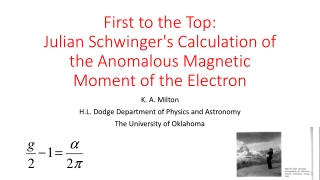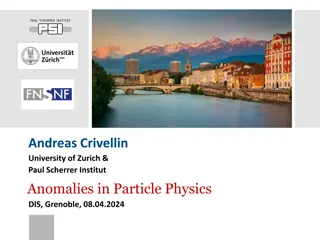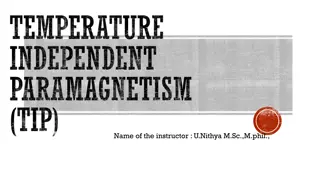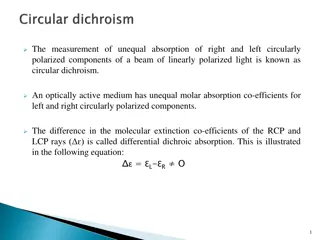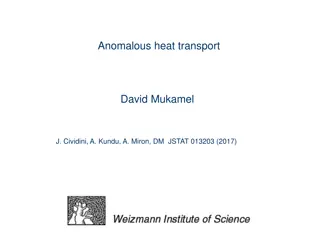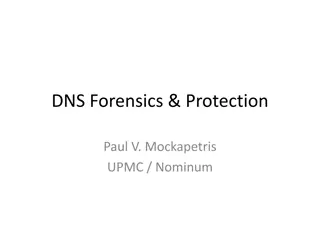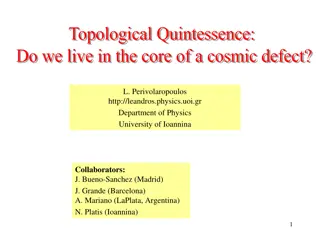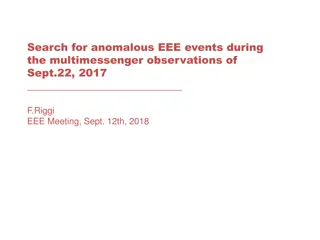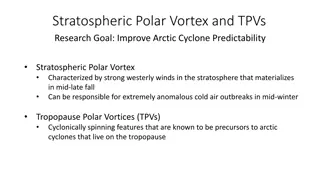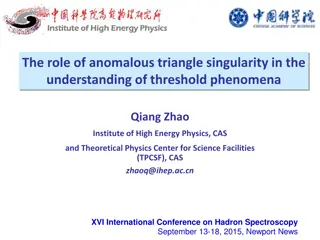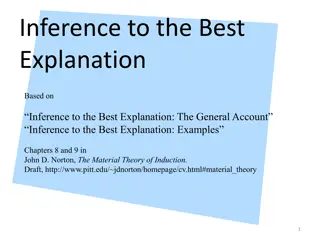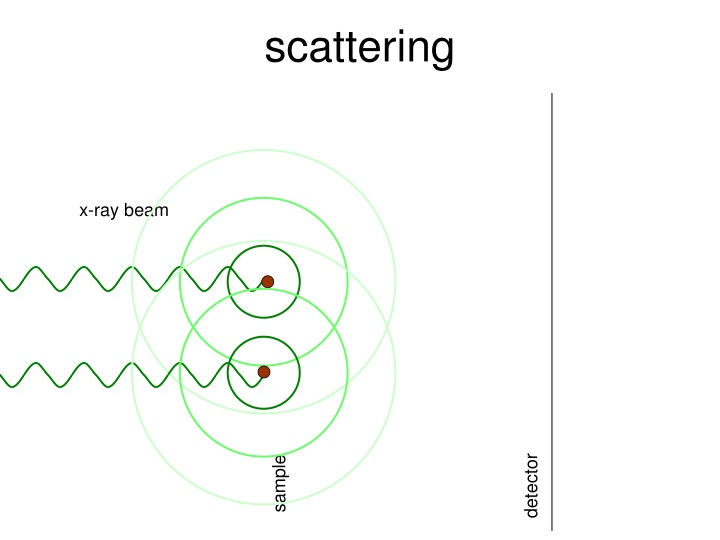
X-ray Scattering and MAD Techniques in Crystallography
Explore the world of X-ray scattering, Bragg's Law, anomalous scattering, and Multiple Anomalous Diffraction (MAD) techniques in crystallography. Discover how photon energy and cross-section play a crucial role in understanding atomic structures using X-ray beams.
Download Presentation

Please find below an Image/Link to download the presentation.
The content on the website is provided AS IS for your information and personal use only. It may not be sold, licensed, or shared on other websites without obtaining consent from the author. If you encounter any issues during the download, it is possible that the publisher has removed the file from their server.
You are allowed to download the files provided on this website for personal or commercial use, subject to the condition that they are used lawfully. All files are the property of their respective owners.
The content on the website is provided AS IS for your information and personal use only. It may not be sold, licensed, or shared on other websites without obtaining consent from the author.
E N D
Presentation Transcript
scattering x-ray beam detector sample
scattering x-ray beam detector sample
scattering x-ray beam detector sample
scattering x-ray beam detector sample
Braggs Law n = 2d sin( ) atom #1 to source atom #2 d sin( )
Braggs Law n = 2d sin( ) atom #1 to source atom #2 d sin( )
anomalous scattering x-ray beam detector sample
anomalous scattering x-ray beam detector sample
anomalous scattering x-ray beam detector sample
anomalous scattering x-ray beam detector sample
anomalous scattering x-ray beam detector sample
4-wavelength MAD 250 200 cross section (cm2/g) 150 ~0 MGy f 100 50 0 12640 12645 12650 12655 12660 12665 12670 12675 12680 12685 12690 12695 12700 photon energy (eV) Holton, J. M. (2007) J. Synch. Rad.14, 51-72.
3-wavelength MAD 250 200 cross section (cm2/g) 150 ~0 MGy f 100 50 0 12640 12645 12650 12655 12660 12665 12670 12675 12680 12685 12690 12695 12700 photon energy (eV) Holton, J. M. (2007) J. Synch. Rad.14, 51-72.
Two-wavelength MAD 250 200 cross section (cm2/g) 150 ~0 MGy f 100 50 0 12640 12645 12650 12655 12660 12665 12670 12675 12680 12685 12690 12695 12700 photon energy (eV) Holton, J. M. (2007) J. Synch. Rad.14, 51-72.
Is it element X ? 250 200 cross section (cm2/g) 150 ~0 MGy f 100 50 0 12640 12645 12650 12655 12660 12665 12670 12675 12680 12685 12690 12695 12700 photon energy (eV)
Suggested anomalous protocol: 1. 360 in < 5 MGy 2. move detector 3. 4X exposure 4. goto 2 2 wavelengths are better than 1 - (peak + inf)/2, and remote MAD, not M-SAD!
Phasing from native elements 100 Solve-able proteins (%) 90 80 70 60 50 40 30 20 10 0 0 50 100 150 200 250 Required signal-to-noise (I/ )
Counting photons (Nphotons) >= Nphotons I/ (I)<= Nphotons Signal-to-noise ratio
Anomalous differences 3% I+ I- 100 photons 100 photons
Anomalous differences 3% I+ I- 100 photons 100 photons
Anomalous differences 3% I+ I- 2000 photons
Anomalous differences 1% I+ I- 20,000 photons
Can you count to 1,000,000 ? sqrt(1,000,000) 1,000,000 Theoretically: = 0.1% Rmeas 0.1% ? ISa = 1000 ISa ~ 33 Rmeas = 3% In reality: sqrt(1,000) 1,000 photon = 3% > 1000 is a waste! spot
Pilatus: subtract smooth baseline ~3x105 photon/pixel Bragg glitch Pick-up tool mark tree rings oxygen inclusions 1% high average 1% low
Potential for improvement realistic simulation + + + + + + + + + 2.8% 26.8 No Perfect detector + - - - - - - - - 0.7% 81.0 Source of error SHSSS + + + + + + + + - 0.7% 74.2 Photon counting Shutter jitter Beam flicker Sample absorption Radiation damage Imperfect spindle vignette Corner correction SHSSS Rmeas( -10 ) I/ asymptotic Holton et al (2014) "R-factor gap", FEBS Journal281, 4046-4060.
Phasing from native elements 100 Solve-able proteins (%) Current technology 90 80 70 Goal 60 50 40 30 20 10 0 0 50 100 150 200 250 Required signal-to-noise (I/ )
Fractional error mult >( ) < F/F> 2 ~3%
anomalous signal F F 1.2 f # sites MW (Da) World record! F/F = 0.5% Wang, Dauter & Dauter (2006) Acta Cryst. D 62, 1475-1483. Crick, F. H. C. & Magdoff, B. S. (1956) Acta Crystallogr.9, 901-908. Hendrickson, W. A. & Teeter, M. M. (1981) Nature290, 107-113.
Anomalous signal 250 6 200 electrons cross section (cm2/g) 150 1 4 100 2 ~0 MGy f 50 0 0 12640 12645 12650 12655 12660 12665 12670 12675 12680 12685 12690 12695 12700 photon energy (eV)
How can I tell: f ? http://skuld.bmsc.washington.edu/scatter/AS_form.html K edge = 4 Atom. No. 20 40 Ca 4.0 Kr 14.3 keV Fe 7.1 Sr 16.1 Zn 9.7 Mo 20 Se 12.6 Ru 22 Br 13.5 Pd 24 L edge = 10 Atom. No. 53 85 I 4.5 Xe 4.8 Cs 5.0 La 5.6 Lu 9.2 Os 10.9 keV Au 11.9 Hg 12.3 Pb 13 Bi 13.4 K edge ~ 0.7*Z-10.6 L edge ~ 0.28*Z-10.2
CCP4: aimless log $TABLE: Analysis against resolution, XDSdataset: $GRAPHS:I/sigma, Mean Mn(I)/sd(Mn(I)):0|0.216023x0|137.14:2,13,14: :Rmerge, Rfull, Rmeas, Rpim v Resolution:0|0.216023x0|1.70834:2,4,5,6,7: :Average I, RMSdeviation and Sd:0|0.216023x0|1650.8:2,10,11,12: :Fractional bias:0|0.216023x0|0:2,15: $$ N 1/d^2 Dmid Rmrg Rfull Rcum Rmeas Rpim Nmeas AvI RMSdev sd I/RMS Mn(I/sd) FrcBias 1 0.0064 12.55 0.020 0.020 0.020 0.021 0.006 13115 1651 57 42 29.2 137.1 - 2 0.0191 7.24 0.027 0.027 0.024 0.028 0.008 24753 1171 47 42 25.0 105.2 - 3 0.0318 5.61 0.038 0.038 0.029 0.040 0.012 32197 857 46 43 18.4 79.6 - 4 0.0445 4.74 0.034 0.034 0.031 0.035 0.010 37743 1212 57 53 21.4 91.2 - 5 0.0572 4.18 0.036 0.036 0.032 0.038 0.011 42642 1181 59 57 19.9 83.8 - 6 0.0699 3.78 0.049 0.049 0.036 0.052 0.015 47224 883 59 57 15.1 65.1 - 7 0.0826 3.48 0.065 0.065 0.040 0.068 0.020 51052 685 59 58 11.7 50.9 - 8 0.0953 3.24 0.096 0.096 0.045 0.100 0.029 54636 448 56 56 8.0 35.0 - 9 0.1080 3.04 0.151 0.151 0.050 0.158 0.046 58072 268 53 53 5.1 22.7 - 10 0.1207 2.88 0.229 0.229 0.056 0.240 0.070 60731 171 51 51 3.3 15.4 - 11 0.1334 2.74 0.314 0.314 0.063 0.329 0.097 63807 125 51 51 2.4 11.3 - 12 0.1461 2.62 0.406 0.406 0.070 0.425 0.125 66241 98 51 52 1.9 8.7 - 13 0.1588 2.51 0.537 0.537 0.078 0.562 0.166 68272 76 53 53 1.4 6.5 - 14 0.1715 2.41 0.685 0.685 0.084 0.727 0.237 54170 61 53 54 1.1 4.4
CCP4: aimless log $TABLE: Correlations CC(1/2) within dataset, XDSdataset: $GRAPHS: Anom & Imean CCs v resolution:0|0.216023x0|1:2,4,7: : RMS correlation ratio :0|0.216023x0|2.20344:2,6: $$ N 1/d^2 Dmid CCanom Nanom RCRanom CC1/2 NImean $$ $$ 1 0.0064 12.55 0.659 499 2.203 1.000 669 2 0.0191 7.24 0.550 975 1.853 1.000 1155 3 0.0318 5.61 0.527 1295 1.798 1.000 1479 16 0.1970 2.25 0.037 2123 1.038 0.711 2275 17 0.2097 2.18 0.043 1682 1.044 0.460 1877
XDS: CORRECT.LP or XSCALE.LP 3.0 AS FUNCTION OF RESOLUTION COMPARED I/SIGMA R-meas CC(1/2) Anomal SigAno LIMIT OBSERVED UNIQUE POSSIBLE OF DATA observed expected Corr 6.39 4103 2517 3135 80.3% 1.7% 1.8% 3018 33.77 2.3% 99.9* 21* 1.012 5 4.54 7339 4970 5544 89.6% 2.6% 2.6% 4585 22.56 3.6% 99.8* 9 0.914 7 3.72 9442 6724 7186 93.6% 2.8% 2.9% 5327 19.99 4.0% 99.7* 9 0.859 8 3.22 11077 7997 8486 94.2% 4.8% 4.9% 6094 12.27 6.8% 99.3* -1 0.784 9 2.88 12408 8851 9595 92.2% 10.0% 10.1% 7068 6.01 14.2% 97.8* -2 0.799 10 2.63 13673 9561 10662 89.7% 20.8% 20.8% 8185 3.10 29.4% 88.8* -4 0.776 12 2.44 14360 9852 11510 85.6% 34.5% 34.7% 8981 1.90 48.8% 75.9* 2 0.765 15 2.28 9501 6495 12416 52.3% 61.8% 59.6% 5991 1.14 87.3% 53.5* -2 0.722 10 2.15 4567 3307 13210 25.0% 120.5% 120.3% 2520 0.59 170.4% 21.9* 4 0.693 4 total 86470 60274 81744 73.7% 6.7% 6.7% 51769 8.97 9.5% 99.5* 2 0.804 83
XDS: CORRECT.LP or XSCALE.LP ****************************************************************************** CORRECTION PARAMETERS FOR THE STANDARD ERROR OF REFLECTION INTENSITIES ****************************************************************************** The variance v0(I) of the intensity I obtained from counting statistics is replaced by v(I)=a*(v0(I)+b*I^2). The model parameters a, b are chosen to minimize the discrepancies between v(I) and the variance estimated from sample statistics of symmetry related reflections. This model implicates an asymptotic limit ISa=1/SQRT(a*b) for the highest I/Sigma(I) that the experimental setup can produce (Diederichs (2010) Acta Cryst D66, 733 a b ISa 3.806E+00 1.080E-04 49.32
140-fold multiplicity 7.4 = Na DELFAN residual anomalous difference
Data collection parameters: 16 crystals 360 each, inverse beam 7235 eV photon energy < 1 MGy per xtal Australian Synchrotron MX1 35 kGy/s into 100 m x 100 m
R factors R = % error
R factors obs F F calc = R F obs completely random: 0.59 starting MR solution: 0.4-0.55 something still wrong?: > 0.3 correct chain trace: < 0.2 small molecule: ~ 0.05
R factors Rcryst(or just R ) observed vs calculated data (Fs) Rfree cross-check with random subset of data should be < 0.3 and < Rcryst + 0.1
Fitting data 1 0.9 data 0.8 0.7 structure factor (F) 0.6 0.5 0.4 0.3 0.2 0.1 0 1 2 3 4 5 6 7 8 9 10 spot index (h)
Fitting data 1 0.9 data 0.8 1 param 0.7 structure factor (F) 0.6 0.5 0.4 0.3 0.2 0.1 0 1 2 3 4 5 6 7 8 9 10 spot index (h)
Fitting data 1 data 0.9 1 param 0.8 0.7 3 params structure factor (F) 0.6 0.5 0.4 0.3 0.2 0.1 0 1 2 3 4 5 6 7 8 9 10 spot index (h)
Fitting data 1 data 1 param 3 params 10 params 0.9 0.8 0.7 structure factor (F) 0.6 0.5 0.4 0.3 0.2 0.1 0 1 2 3 4 5 6 7 8 9 10 spot index (h)
R factors Rcryst(or just R ) observed vs calculated data (Fs) Rfree cross-check with random subset of data should be < 0.3 and < Rcryst + 0.1 Rsym = Rmerge (self-consistency of data: Is)
Rmerge = I I obs merge R I blows up as Iobs 0 obs completely random: 0.59 0.7- weak data (high angle): wrong symmetry choice?: ~0.2-0.55 small or disordered crystal: ~0.1-0.2 typical: ~ 0.05
R factors Rcryst(or just R ) observed vs calculated data (Fs) Rfree cross-check with random subset of data should be < 0.3 and < Rcryst + 0.1 Rsym = Rmerge (self-consistency of data: Is) Rrim Rpim Rmeas Riso Ranom Rdiff Rsymis unfair to high multiplicity

